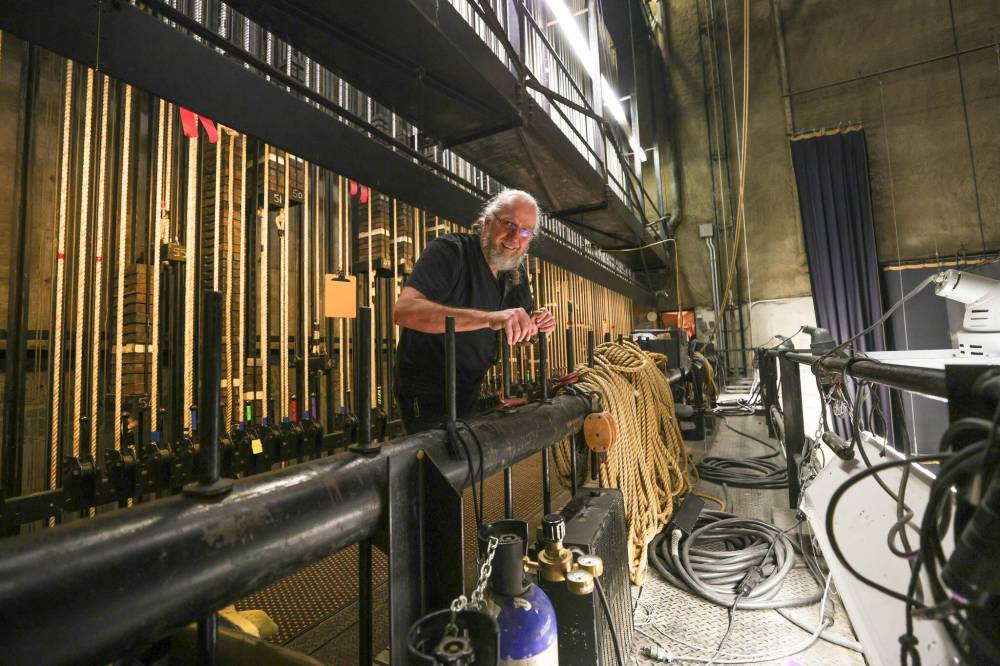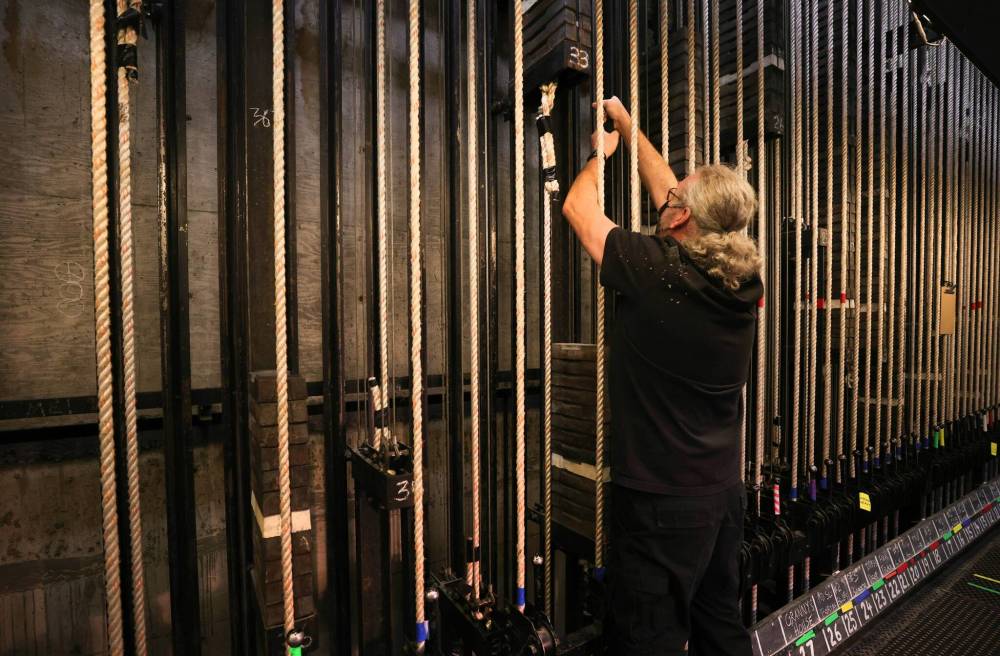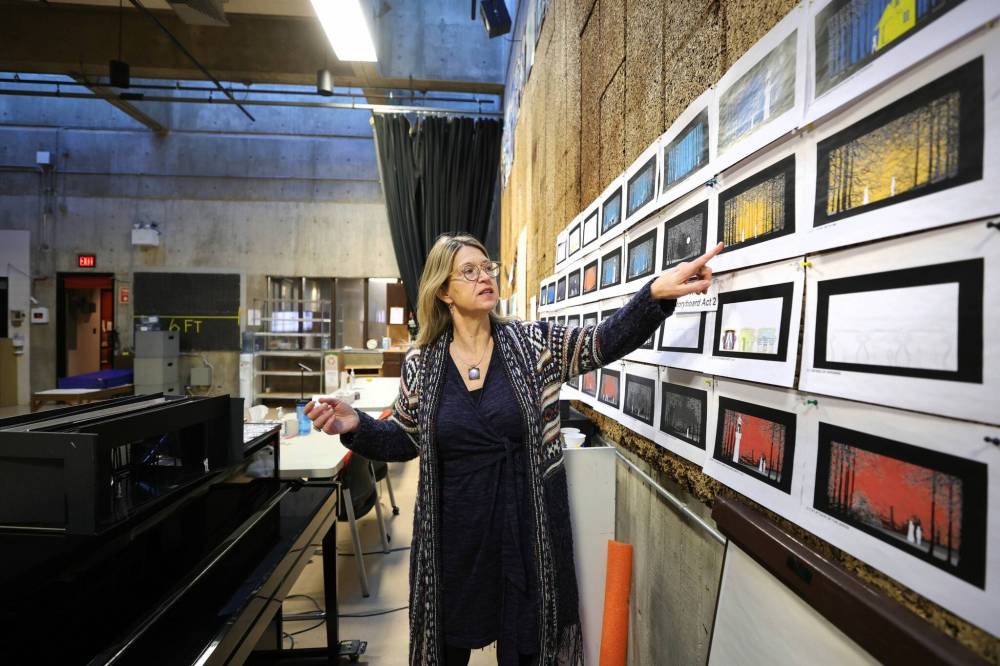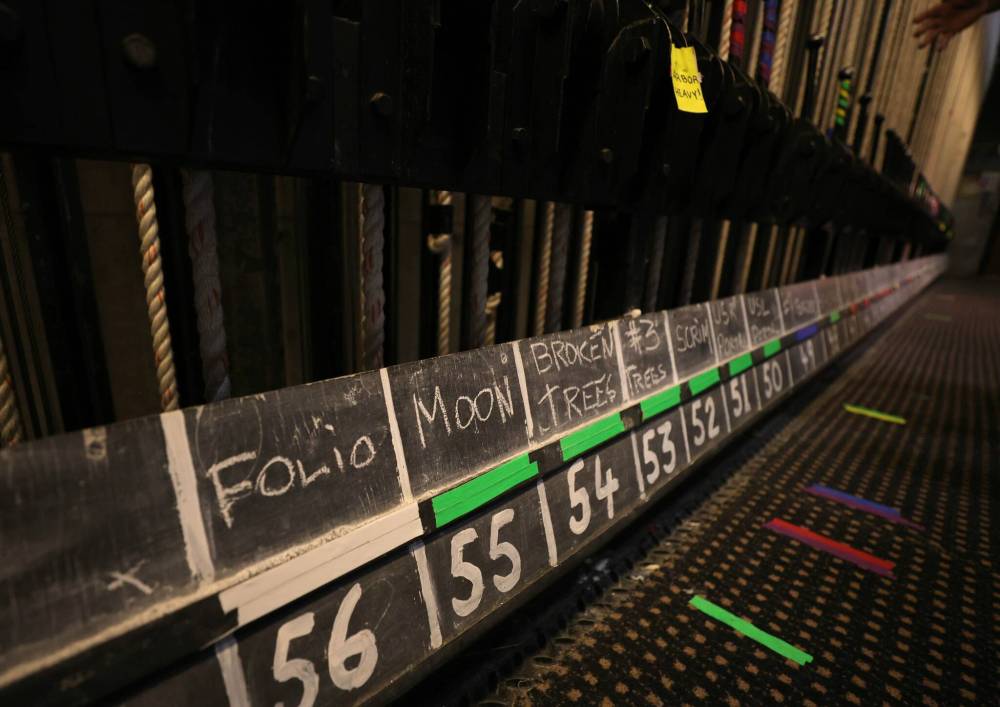Setting the stage Without Gary Plouffe’s work in the fly gallery, audiences at Into the Woods wouldn’t see the forest or the trees
Read this article for free:
or
Already have an account? Log in here »
To continue reading, please subscribe:
Monthly Digital Subscription
$0 for the first 4 weeks*
- Enjoy unlimited reading on winnipegfreepress.com
- Read the E-Edition, our digital replica newspaper
- Access News Break, our award-winning app
- Play interactive puzzles
*No charge for 4 weeks then price increases to the regular rate of $19.00 plus GST every four weeks. Offer available to new and qualified returning subscribers only. Cancel any time.
Monthly Digital Subscription
$4.75/week*
- Enjoy unlimited reading on winnipegfreepress.com
- Read the E-Edition, our digital replica newspaper
- Access News Break, our award-winning app
- Play interactive puzzles
*Billed as $19 plus GST every four weeks. Cancel any time.
To continue reading, please subscribe:
Add Free Press access to your Brandon Sun subscription for only an additional
$1 for the first 4 weeks*
*Your next subscription payment will increase by $1.00 and you will be charged $16.99 plus GST for four weeks. After four weeks, your payment will increase to $23.99 plus GST every four weeks.
Read unlimited articles for free today:
or
Already have an account? Log in here »
Hey there, time traveller!
This article was published 11/01/2023 (1061 days ago), so information in it may no longer be current.
Gary Plouffe can lift an enchanted forest into the sky.
And he does it without the assistance of magic, just by virtue of his access to a few classical tools of engineering: levers, pulleys, counterweights and every single muscle in his upper body.
Plouffe is the house stagehand at the Royal Manitoba Theatre Centre, and as such, plays a key role in the constant transformation of the setting during any production at the mainstage. But unlike the set pieces he raises and drops from his perch in the fly gallery, Plouffe is invisible to the audience sitting on the other side of the proscenium.
He works behind, around and above the scenes.
Plouffe is tall, burly and jovial, with a long grey ponytail that flicks behind him as he struts gently across the catwalk. His domain is the fly gallery, where he controls a precisely and intricately organized series of cables, each connected to different elements of the set down below.
On the other end of each line from those elements is a stack of bricks, its weight calibrated to counter the heft of the pieces of the set itself. With a combination of grace and tension, those working the fly gallery must lower each element to the ground and raise it back to the rafters without making so much as a sound.
“It’s a bit of an artform in itself,” Plouffe says.
RUTH BONNEVILLE / WINNIPEG FREE PRESS House stagehand Gary Plouffe in his happy place, the fly gallery above the stage.
On Into the Woods — Stephen Sondheim and James Lapine’s musical flight of fancy and fantasy, which runs to Feb. 4 at RMTC — Plouffe is the giant at the top of the beanstalk, controlling set designer Gillian Gallow’s forest, inspired by the Brothers Grimm and Arthur Rackham, the Victorian artist who in the early 20th century illustrated dozens of the Grimms’ folk tales in his nimble ink and pen.
Plouffe is an old hand in the stagehand game. In his high school theatre days in St. Boniface, he was uninterested in acting, gravitating instead to a different line of work.
“The teacher said, ‘We need someone to work the lights and the sound effects.’ I said, ‘Oh, I could do that.’”
At 17, Plouffe started working at Théâtre Cercle Molière, where his future came into focus.
Theatre preview
Into the Woods
By Stephen Sondheim
● John Hirsch Mainstage, Royal Manitoba Theatre Centre
● To Feb. 4
● Tickets at royalmtc.ca
“I walked into the control booth, and I saw the soundboard and all the faders and knobs and I went ‘Ahhhhh. This is it. This is what I want to do.’”
Plouffe plied his trade for decades and, several years ago, began working with RMTC as a casual. Now in his sixth season as the house stagehand, Plouffe has his art down to a science, and his science down to an art.
Across the base of each of the 65 arbours, Plouffe writes the stage element that corresponds to each of the respective flies. He has developed over the years a system of colour-coded and mnemonic cues to help him identify quickly which cables are associated with what.
A cable connected to a thicket of trees is marked as No. 3 because tree sounds like three. Alliteratively, cables on the right are marked with red tape. Blue tape corresponds with cables on the left. Plouffe’s reasoning for that is that the left side of a boat is called port, and port and blue have four letters each. If it works, it works.
A few days before the first production, he quietly navigates the fly gallery, walking gingerly across a carpeted strip of floor.
“The sign of a good (stagehand) is that you have to do things quickly, but with finesse,” Plouffe says. However, even seasoned veterans are not immune to clumsiness. During the orchestra rehearsal for Into the Woods, a particularly heavy set piece landed squarely with a thud.
“The flies on this show are intense. We really built a magical forest that is ever-changing,” he says.
RUTH BONNEVILLE / WINNIPEG FREE PRESS Stagehand Gary Plouffe’s role as flyman requires a lot of upper-body strength.
To do Plouffe’s job requires strength: the cast bricks are awkward to lift with one’s hands, but to Plouffe, they’re nothing. The bricks weighing down the cables at Rainbow Stage, where he works in the summers, weigh about 1 1/2 times more. “So this is a real treat,” Plouffe says, laughing.
“This is my happy place,” he says, leaning his left hand on a nearby railing. “It’s quiet. There’s a lot of hurry-up-and-wait. You can sit in your chair and read a magazine.”
During the show, Plouffe’s vision of the stage is obscured. But from the technical gallery, he is able to see slivers of the crowd and hear their response.
If he is doing his job, nobody ever notices he’s even up there.
ben.waldman@winnipegfreepress.com

RUTH BONNEVILLE / WINNIPEG FREE PRESS
Artistic director Kelly Thornton shows storyboards for Into the Woods, Stephen Sondheim’s musical now playing at RMTC.

RUTH BONNEVILLE / WINNIPEG FREE PRESS
Long run levers, operated manually by a person called the flyman, control various scenic elements of a play.

RUTH BONNEVILLE / WINNIPEG FREE PRESS
Chalkboard markings correspond with sets of levers that operate scenic elements of Into the Woods at RMTC.
Two Sondheim fanatics go Into the Woods
Designer Gillian Gallow and director Kelly Thornton have at least one thing in common: they love Stephen Sondheim.
Sondheim, who died Nov. 26, 2021, ago at 91, is considered one of the greatest contributors to modern musical theatre. If you have snapped your fingers to West Side Story, snipped your hair and thought of Sweeney Todd, or spent a Sunday in the Park with George, you owe that experience to the creative force of nature that was Sondheim.
Designer Gillian Gallow and director Kelly Thornton have at least one thing in common: they love Stephen Sondheim.
Sondheim, who died Nov. 26, 2021, ago at 91, is considered one of the greatest contributors to modern musical theatre. If you have snapped your fingers to West Side Story, snipped your hair and thought of Sweeney Todd, or spent a Sunday in the Park with George, you owe that experience to the creative force of nature that was Sondheim.
Gallow and Thornton share at least one more similarity: neither had ever worked on one of the legend’s shows before enlisting in RMTC’s mainstage production of Into the Woods, a show that won three Tony Awards after its Broadway debut in 1987. The show runs from Jan. 10 through Feb. 4.
Thornton, who is also the theatre’s artistic director, views Into The Woods as a fable weighing selfish pursuits against collective responsibility. It’s a funny little fairy tale as old as time.
“It’s a very interesting story about how Sondheim and (librettist James) Lapine put this story together,” says Thornton. Sondheim wanted to create a musical that doubled as a quest. “But Lapine said fairy tales are so simple, and they’re so short, it’s hard to develop them into a full musical.”
So a pair of new characters was placed at the heart of the story: a baker and his wife, who fall victim to a wicked witch’s old curse. To reverse the curse, the characters must go into the woods. Meanwhile, they interact with classic characters such as Little Red Riding Hood.
Since the musical’s debut, it has been adapted into an Academy Award-nominated film and continued as a beloved musical. So Thornton and set/costumer designer Gillian Gallow had their work cut out for them in making the familiar world of the forest new again.
Gallow, a Toronto-based designer who worked on RMTC’s production of God of Carnage, says what drew her to Sondheim was his commitment to his characters’ narrative arcs.
“Sometimes, musicals are very surface-level, and all about the singing and dancing,” Gallow says. In Into the Woods, Gallow says Sondheim makes the audience care about every character. Even the dairy cow.
In her set designs, Gallow fixated on the artwork of Arthur Rackham, a turn-of-the-20th-century artist who illustrated the stories of the Brothers Grimm. That inspiration led Gallow to develop a forest that often leans into dark territory.
“What felt important to me was (to illustrate) the feeling of being entangled, confused, or lost,” she says. “They have to go through this labyrinth, losing their path and realizing they need each other.”
Thornton says she never wanted the audience to feel as if it was in the same forest for too long.
As important as it is to consider what is included in Thornton and Gallow’s vision of the forest, it’s equally valuable to consider what is omitted.
“What we’ve decided in our production is that it is far more interesting to not see the giant (atop the beanstalk), and to be curious about him and to see his effects,” Gallow says.
The characters we do meet, Thornton says, are witty and whimsical, much like Sondheim and the universe he built through music and lyrics.
“I just think his world is just so rich,” she says. “People might think, ‘Oh, it’s just a bunch of fairy tales mashed together.’ But it actually has such gravity.”
It’s Sondheim’s forest. Thornton and Gallow are happy to have been invited in.

Ben Waldman covers a little bit of everything for the Free Press.
Our newsroom depends on a growing audience of readers to power our journalism. If you are not a paid reader, please consider becoming a subscriber.
Our newsroom depends on its audience of readers to power our journalism. Thank you for your support.







